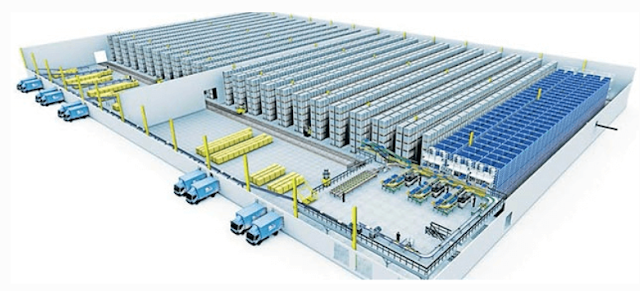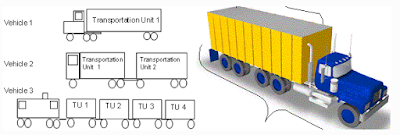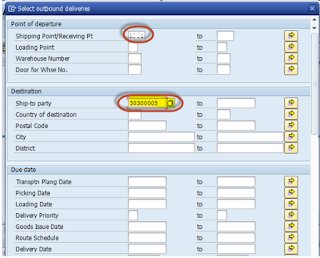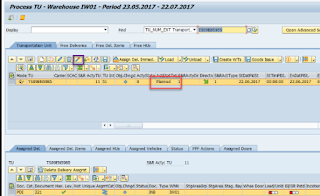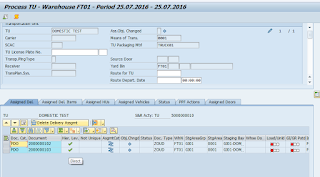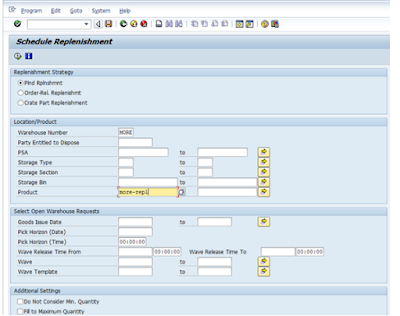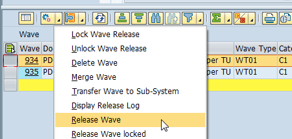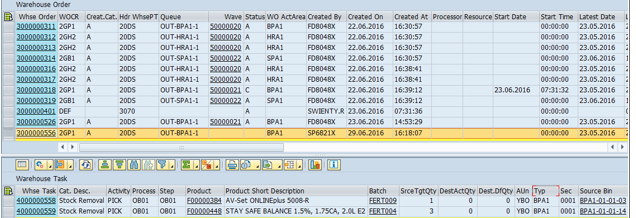In general, a warehouse and its contents are of no value,
rather a major cost driver.
Its main purpose is to provide time and place utility to
satisfy customer needs. Without the need for time and place utility a warehouse
is of no purpose.
To provide time and place utility one of the fundamental
aspect relates to efficacy, efficacy of picking, packing, labeling and
shipment on time and in full of the correct ordered goods.
A high-volume warehouse will have many Transportation Units
(TU) arriving throughout the day to load and deliver. These TU are of different
size and will load packed boxes and pallets for delivery to different routes:
deport for export, or from cross dock and de-consolidation or direct delivery.
This implies that the warehouse must synchronize picking so
that goods are available with agreed loading time frame, correctly packed and
labelled for loading.
From SAP perspective the key processes are as follows:
·
Sales orders are generated for customer to
provide specific products at a desired date. Normally different order types are
created to deal with exports, domestic ect..for ship to parties that are on a
specific route. The sales order may have item quantities that may be defined as
items, box or pallets. The sales order may contain specific batches or may
contain a batch search strategy to determine ideal batches. The confirmed dates
with respect to availability validate available qty and delivery date that is
theoretical (rarely takes into consideration supply chain and warehouse issue)
·
Other types of outbound are triggered by stock
transfer order for inter plant transfer. Quantities may be optimized based on
type of planning system used of simply derived by MRP
·
Deliveries for the respective sales orders are
then created based on available warehouse stock. Delivery creation considers the
warehouse as block box: indifferent of availability single items, boxes and
cartons, indifferent of the transportation unit capacity (possible up to a
point if APO Transportation load Builder) , indifferent of load optimization or
load sequencing
Deliveries are the key enables for commencing EWM warehouse picking
operations. Different type of deliveries will determine if for cross plant
transfer, domestic or export. In high volume warehouse picking by deliveries
not an option. This will result in in operational delay, confusion and
inefficiencies.
The ideal operational process flow is to ensure operational
efficiency. This is done as follows:
ASSIGNMENT OF
DELIVERIES TO SHIPMENTS
1. Collect all the deliveries and assign to a
Transportation unit. Each transportation unit represent
a specific vehicle.
o
In ERP to limited extent. No truck load
optimization is possible load sequencing. Shipment creation allows selection
and deliveries to be included with following selection criteria:
Delivery selection
Transportation criteria
Once created system generates shipment document with assigned deliveries
Shipment document is then replicated to EWM by means of IDOC which in
turn creates a Transportation unit with assigned deliveries.
The above creation limitation does not have any form of load optimization
and delivery grouping simplistically grouped.
o
Creation of Transportation unit in the EWM
system. This is possible from shipping cockpit functionality that displays all
the deliveries, planner then selects deliveries to be grouped in newly created
TU.
Shipment cockpit via transaction NBWC (not part of SAP GUI transactions)
Deliveries displayed in cockpit
Transportation Unit creation criteria
Created Transportation unit with assigned deliveries. The transportation
unit are not optimized in terms delivery route and load optimization.
o
Manually create Transportation Unit via
transaction /SCWM/TU and assign deliveries.
TU creation criteria
Assign deliveries
Created TU with assigned deliveries
o
Alternative way via third party solution. This
implies sending delivery documents via IDOC or other to external system that
manages routing and load optimization. This third-party software will then have
grouped deliveries in unique shipping units that are optimized by route and are
loading volume optimized. These shipping units with assigned deliveries,
product and qty are then interfaced (custom) ideally into EWM system by
creating a Transportation Unit with assigned deliveries in the EWM system. Possible vendor : https://ortec.com/
Note:
in all cases it possible to split deliveries across multiple TU due to load
optimization and constraints.
Up to this process step SAP
functionality has all the capabilities to create shipment but not perfectly
optimized unless third party tool is used.
Depending on the business complexity with respect to
delivery route management and load optimization it may be the standard offering
within SAP and EWM may be adequate with a simple enhancement if needed.
Once we have the TU with assigned deliveries EWM can then
really earn its value by triggering the follow-on step. This where EWM has all the functionality to carry-out effective and efficient picking and shipment.
At this point we have in the system many TU but it does not
mean that the warehouse items are ideally stocked. TU are now structured as
follows:
TU per vehicle and has expected planned date and time (approximate)
Deliveries
TU per vehicle and has expected planned date and time (approximate)
Deliveries
Deliveries may allow for peace’s, carton, packs a and
pallet. Also, it may be that pallets are stored in high bay warehouse where
some form of FEFO logic is needed.
EWM offers replenishment that can either based on min levels
or order-based replenishment. The selection of how to manage the replenishment
criteria depends has pros and cons.
Important to note that both methods trigger replenishment activities
that may not be completed on time to satisfy TU:
·
Planned replenishment check all stock levels and
is indifferent to outbound requirements. Limit this to single peace picking
areas such a vertical carousel or pick to lite systems
·
Order based considers deliveries and is
indifferent to planned shipments
·
Ideally order based should be based on planned
TU, but TU is not part of selection criteria
Moving on:
PRE PLANNING THE SHIPMENTS
Once the TU are in place with expected date and time
carry-out the following steps:
Yard management.
This is an optional process, dependency
is based on complexity, volume of vehicles and control that is required. Yard
functionality to be used for check in of vehicle, weighing, sealing and
check-out
Functions related to yard mgt
In the shipping cockpit
Assign door. This will be the door TU will
arrive to be loaded. Important to setup goods issue bins to relevant door. This
is fundamental for warehouse task such that pick destination bin displays goods
issue bin associated to bin.
Staging bay door relationship.
Shipping cockpit the clearly displays that
TU assigned to door
TU visibility and status of door assignment.
Assignment of the door to TU automatically
assigns door to delivery.
At this point in time may be necessary to
modify TU date and time. Note: if this is done once picking is started then WO
date are not adjusted therefore enhancement is required. This is fundamental to
re-sequencing WO picking which is based on system guided picking.
Assign wave. Once door is assigned assign wave
to the TU. Wave creation will then trigger picking and this is where efficacy
is gained in that picking managed because automated. Even is not all warehouse
are created, planned job (say every 10 minutes) will re-release the wave to
create any outstanding picks.
Wave can either be manually assigned or
automatically. Once wave is created depending on type of release warehouse
tasks are created where picking strategies are successful.
Possible option is to create wave that are
not released: this will then require further step within the cockpit to release
the wave. Decision of not releasing wave on creation depends on timing and pick
volumes. Create wave not released enables replenishment to already consider
these TU that have wave assigned but not yet started. Release the wave within narrow
window to trigger picking.
It is now fundamental to set-up
replenishment to run based on orders but with wave template defined. This
implies that deliveries are selected that are assigned to TU and have specific
wave template assigned. Consider enhancement to sort deliveries for
replenishment based on TU sequence. This ensure that replenishment tasks
sequenced accordingly.
Further enhancement is required to consider
batch search strategies associated to outbound delivery must be considered when
carry-out replenishment. No use having replenishment for batches that do not
fit batch search strategy.
Further enhancement is needed if there is a
need for multi-level replenishment: pallet > carton>peace’s.
Very important: activate wave mgt
for replenishment, this is fundamental to automate steps and avoids excessive human
effort. Operator effort purely manage exception where Ware task creation fails.
Carry-out picking. Wave release will trigger warehouse
tasks creation. Efficacy all depends on smart pick strategies are defined. Wave
via background job will automatically be released in background to create any
missing warehouse tasks due to replenishment tasks running in background.
Warehouse order creation rules, queue assignment is fundamental to ensure
warehouse order efficacy. This is to ensure that picking tasks are assigned to
correct type of resource.
Warehouse order, associated to wave, queue with
assigned warehouse tasks. Sequencing of WO must correspond
to TU sequencing. This to ensure that when relevant truck arrives products are
ready to be loaded.
99% picking activity either carried out via
RF, automated crane system, pick to lite, voice pick. the remaining 1% managed
manually only for exception. High number manual process confirms badly designed
signed.
5.
Labeling
Once picking commences labels are needed.
Normally if full pallet picking is carried, re-use of existing HU may be
possible. It may that customer specific labels may be needed. Mass printing of
labels will be disastrous for any warehouse operation. Labels need to be
printed on demand associated to resource that is doing the picking. This why small label printers attached to
belts of RF operator or fork lift trucks will ensure correct label for correct item
that is picked.
Documentation
Many EWM implementations carry-out the usual error by printing delivery notes and packing list from ERP system instead of EWM. This causes all
sort of problem in that there is dependency for goods issue to be carried out
in ERP to print documentation. Ideal solution is to print documentation from
EWM system rather than ERP system.
Loading
Loading
EWM offers the ability to create loading
WT, important to understand need for this kind of detail. It may result in unnecessary
system effort. Simply update by updating loading in TU to indicate loading
complete. Loading complete status can be used to automatically trigger printing
of delivery note and packing lists.
Close shipment
There may be requirement to update seal
number, this may be done at TU level and vehicle level as well as update from
weighing station.
Departure from checkpoint then closes the TU
and is further critical event to trigger update to ERP system of the TU so that
shipment is created and if necessary shipping cost generated.
Conclusion
In any warehouse the real value is picking. Warehousing and shipment process to satisfy time and place utility which generates income (billing). Therefore, efficacy within warehousing solution is critical:
In any warehouse the real value is picking. Warehousing and shipment process to satisfy time and place utility which generates income (billing). Therefore, efficacy within warehousing solution is critical:
·
Efficacy
in system operation
·
Efficacy
in actual warehouse operation by resource.
